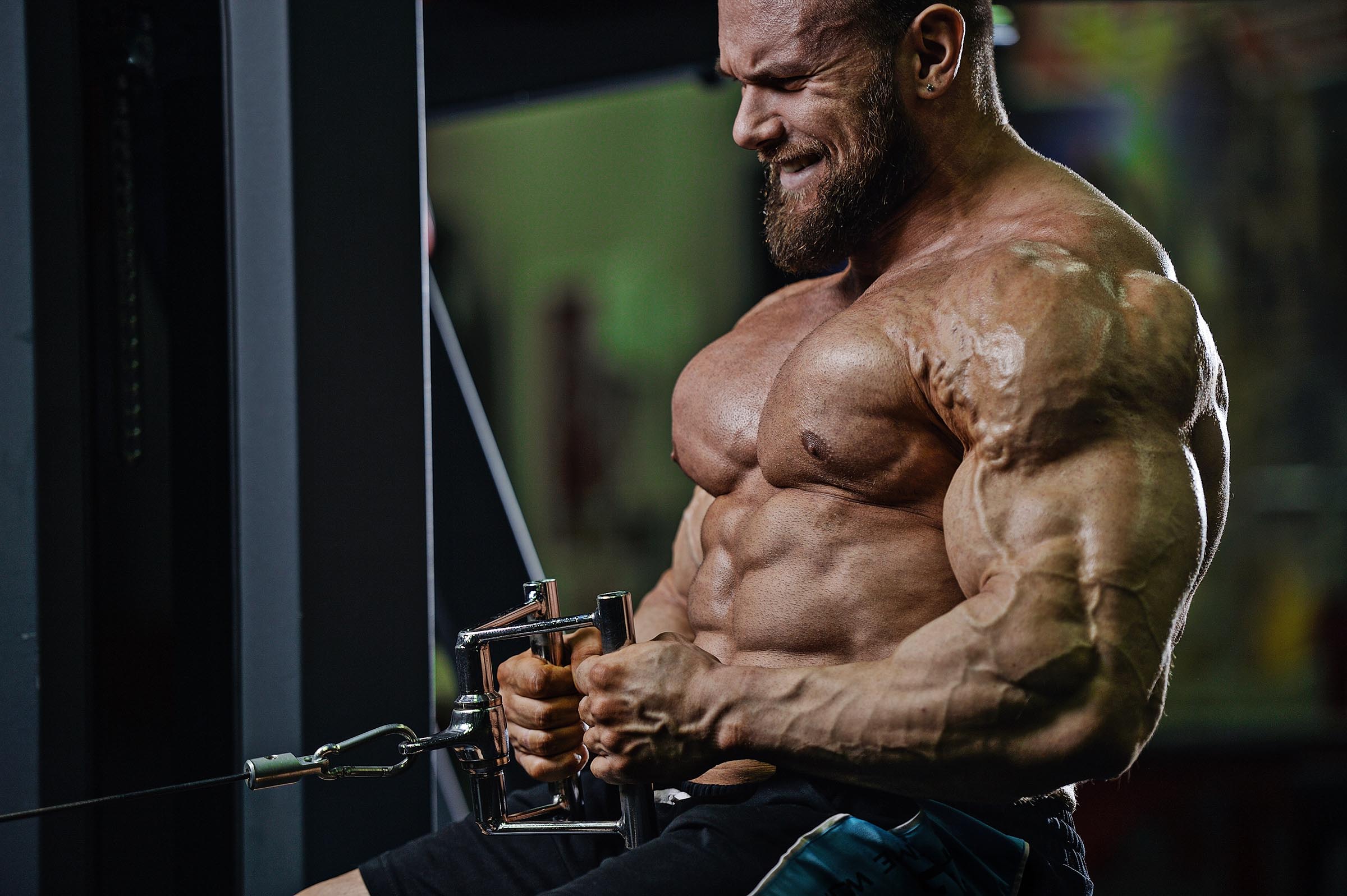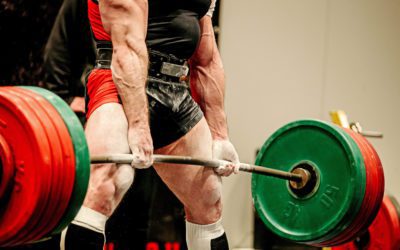3 Ways to Manipulate Muscle Fatigue for Hypertrophy

All athletes deal with fatigue, but bodybuilders need to use it to their advantage as much as possible. How do you know if you’re working hard enough in the gym and hitting your growth potential? Do you even pay attention to your rest intervals?
Joseph Lucero, owner of Harvesting Strength, is a powerlifter and strongman coach with years of practical S&C experience in high school, collegiate, and professional settings. Check out his top 3 methods for maximizing your fatigue and muscle gains: lower your rest times, use proper exercise selection, and try different training modalities.

How Important Are Rest Intervals For Bodybuilders?
About six months ago, a training client asked me, “Hey, is there any way we can speed up the workouts? I feel like I’m in the gym for 2-3 hours at a time.”
Now for some of us, that doesn’t seem to be the worst case scenario, but if you’ve got a family to be responsible for, it can feel like every minute of every day is accounted for. He was concerned his workouts were taking too long, so I broke down his workouts and asked him one simple question…
“Are you abiding by the prescribed rest intervals on your workout sheet?”
Spoiler alert: he was not.
Respect The Stopwatch
I’ve experienced many impactful moments in my life that have shaped my mindset on strength training. Weirdly, one of those moments puts me at a local YMCA. I was training in an ordinary fashion, nothing special, doing sets of bench press, dumbbell incline press and some other pressing accessories. I noticed another lifter nearby — he had an impressive physique.
I’d seen him lifting routinely each week and his body composition indicated he wasn’t just lifting for strength, but for size as well.
He was constantly staring at his stopwatch. It seemed as though the only focus of his workout was between him, the iron, and that damn stopwatch he was wearing. Eventually I built the courage to ask, “Hey, what’s the deal with the stopwatch?” He sort of smirked at me, looked down at it and said, “It’s to pace my workout and rest intervals.”
I guess in hindsight that’s probably the only reason to use a stopwatch during a workout, right? But I think in the big scheme of things how you conduct your workout is a HUGE indicator of how your body will respond to the stimulus.
Let’s imagine two individuals doing the same exact workout but in two different time domains:
Athlete A is performing bench press, incline press and cable pushdowns within 30 minutes of training.
Athlete B is performing bench press, incline press and cable pushdowns within 60 minutes of training.
Both athletes are doing the same exact workout including volume and percentages, but Athlete A only has half the amount of rest. How do you feel this person will respond to this pacing? I imagine they’ll be exhausted and dripping in sweat.
Working to “exhaustion/fatigue” is a big indicator for evoking spikes in the body’s secretion of growth hormone. That’s a huge factor in performance and size gains, especially for those who focus on bodybuilding.
Change the Way You Train
Using Fatigue For Muscle Growth
1. Lower Your Rest Intervals (Or At Least Pay Attention to Them)
One of the first ways to manipulate fatigue for bodybuilding success is to abide by rest intervals. Say you’re doing bench press for five sets of eight reps with three minute rest periods. This means you’ll be benching for 15 minutes or more. That’s a long ass time. I mean, for a powerlifter this should be no problem, right? But if we change the rest interval to two minutes or 90 seconds, then you’re benching for 8-10 minutes, which gives you more time back to invest into other movements for a specific training window.
If you typically train with certain rest rates and decrease them by a significant amount, this means you’re not allowing yourself to return to a full state of rest. It makes the workout harder, which jacks up muscular fatigue.
Remember, a big part of activating the natural secretion of growth hormone is evoking a higher level of fatigue. If you’re a powerlifter looking to hit a PR, maybe you don’t decrease the rest rates of your major sets, but as the workout continues, consider lowering the rest rates for better implementation of fatigue.
Is there a standard to achieve here? Not necessarily, but also understand that as time goes on your conditioning will improve. Try dropping your rest rates down by 15-20% or so and continue to chip away at those intervals.
2. Choose Your Exercises Intentionally & Order Them Wisely
Another way to boost your fatigue to your advantage is to use proper exercise selection and exercise order. For the traditional rep scheme of 3×10, think about doing it for bicep curls vs. squats. If you do bicep curls for 3×10, it can get tiring, but 3×10 squats is asking for a death sentence!
Squatting this volume is insanely hard, but why? Because the squat is a multi-joint (compound) movement that utilizes massive amounts of muscle tissue. Squatting uses your entire posterior chain, core and even your upper body to some extent, which makes it a very metabolically exhausting exercise. Doing bicep curls just uses your biceps, so you do the math, Archimedes!
It’s pivotal that you script out a workout including a series of both multi-joint and single-joint (isolation) exercises to follow in an order that makes sense. You want to go from multi-joint to single-joint as this allows your body to again evoke a spike in exhaustion, triggering growth from a fatigued state. Don’t do leg extensions before barbell squats, that’s a silly waste of your training capacity.
Also, don’t forget about the planes of movement. Try not to perform movements that are constantly the same physiologically. Aim to do exercises in motion, in place, with all available equipment: machines, dumbbells, barbells, etc.

3. Explore Different Training Modalities
One more method of increasing your capacity for muscle growth is to utilize different types of training modalities. So far we’ve talked about using unique rest rates and specific types of exercise selection, but it’s also important to exercise using different styles of training specifically for growth.
That means doing things such as mega sets, drop sets, or even biomechanical drop sets. Mega sets involve training to a certain goal of volume, such as 1×80,100,120, or even 200! You pick a weight that you can use for 20 reps or more of an exercise and use this intensity until you hit fatigue. Rest for ten seconds at most, then get back to work until you hit your goal of reps for that set.
I work my clients up to mega sets by aiming to hit 50-80 reps in their first week. The next week I drop the load and ask them to go for 100 reps in a single set. I keep building intensity throughout a block of training and then we try another type of fatiguing modality to aim for the next block.
Drop sets are a similar concept, but as you hit fatigue, you cut the load by a small percentage and continue to lift until you’re basically dead. I could ask a client to drop set for 100 reps, or I could ask them to drop set for five intervals to see how many reps they accumulate and track that progress each week.
Biomechanical drop sets are another brutal method of getting in more work — as you hit fatigue for a lift, modify the movement to make it easier and easier each time you progress to maximal fatigue. It could mean doing incline press, then flat bench press, then decline press at the end so you hit fatigue from different angles, starting from a harder angle to an easier angle. You can also go from a strict form of a movement to a momentum-based or half-rep version.
Find Your Perfect Training Plan
Sometimes all you need to reach your destination on your fitness journey is an expert guide. We've got you covered. Browse from thousands of programs for any goal and every type of athlete.
Try any programming subscription free for 7 days!
Want Training Tips, Exercise Guides & Knowledge Bombs Sent to Your Inbox?
Sign up for the FitNerd newsletter from TrainHeroic
Related articles
32 & Lifting: Reflections on My First Powerlifting Competition
Stepping onto the powerlifting platform at 32, just 13 months post-ACL surgery, Fred Ormerod chronicles his return to competitive sports after a 14-year hiatus. From shedding over 15kg to meet weight class requirements to confronting self-doubt and embracing the...
Active Recovery Strategies for Strength Athletes
Active recovery isn’t just about taking it easy—it’s a smart way to keep your body moving, boost circulation, and enhance performance without adding fatigue. While passive recovery has its place, low-intensity movement between sessions helps reduce stiffness and...
Intermittent Fasting for Shift-Working Athletes
Shift work can make fueling for performance feel like a constant battle. Between erratic schedules, disrupted sleep, and unpredictable training windows, sticking to a nutrition plan can be tough. Intermittent fasting (IF) offers a flexible approach that may already...

Join the community
Sign up for the latest training news and updates from TrainHeroic
Support
Made with love, sweat, protein isolate and hard work in Denver, CO
© 2023 TrainHeroic, Inc. All rights reserved.







